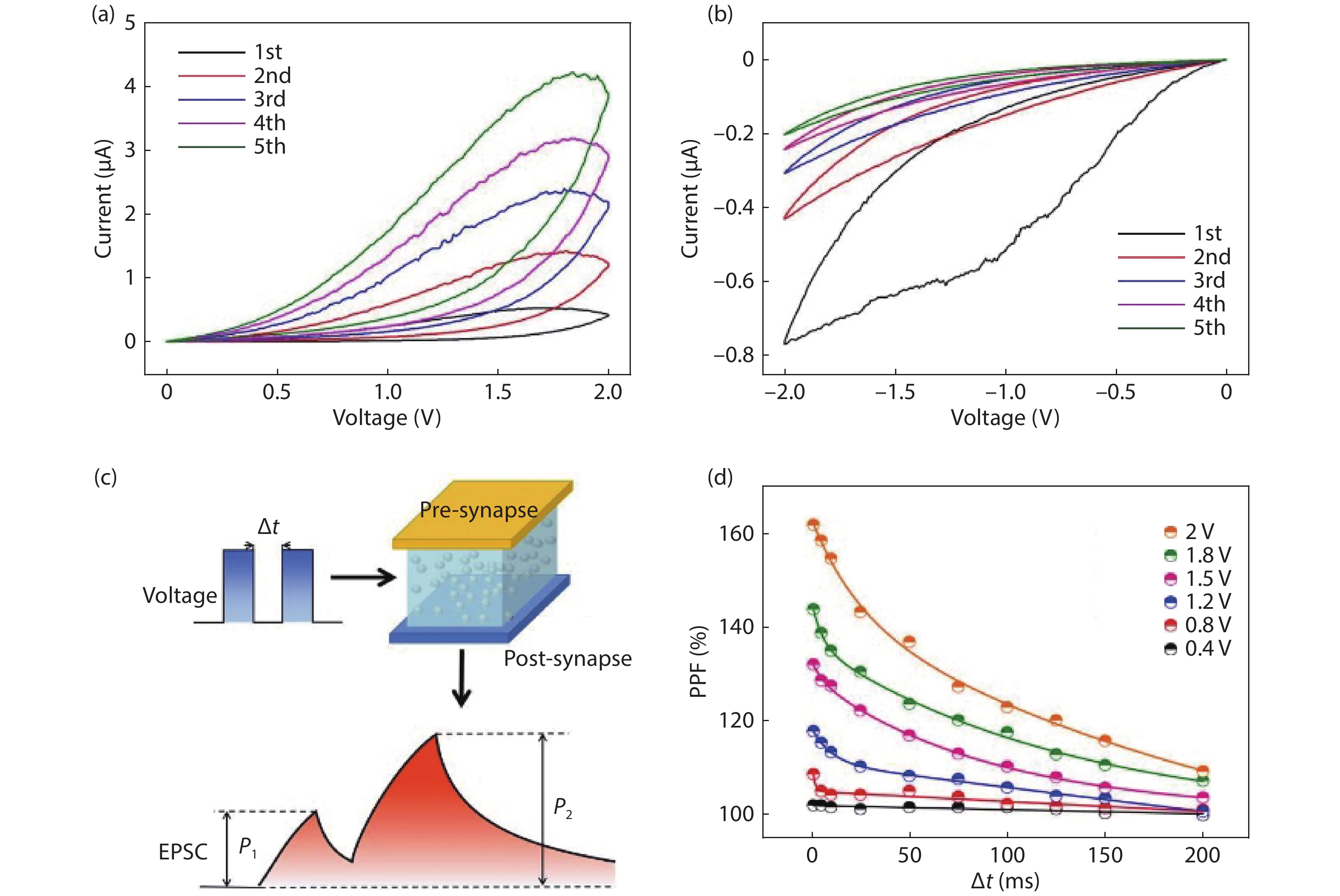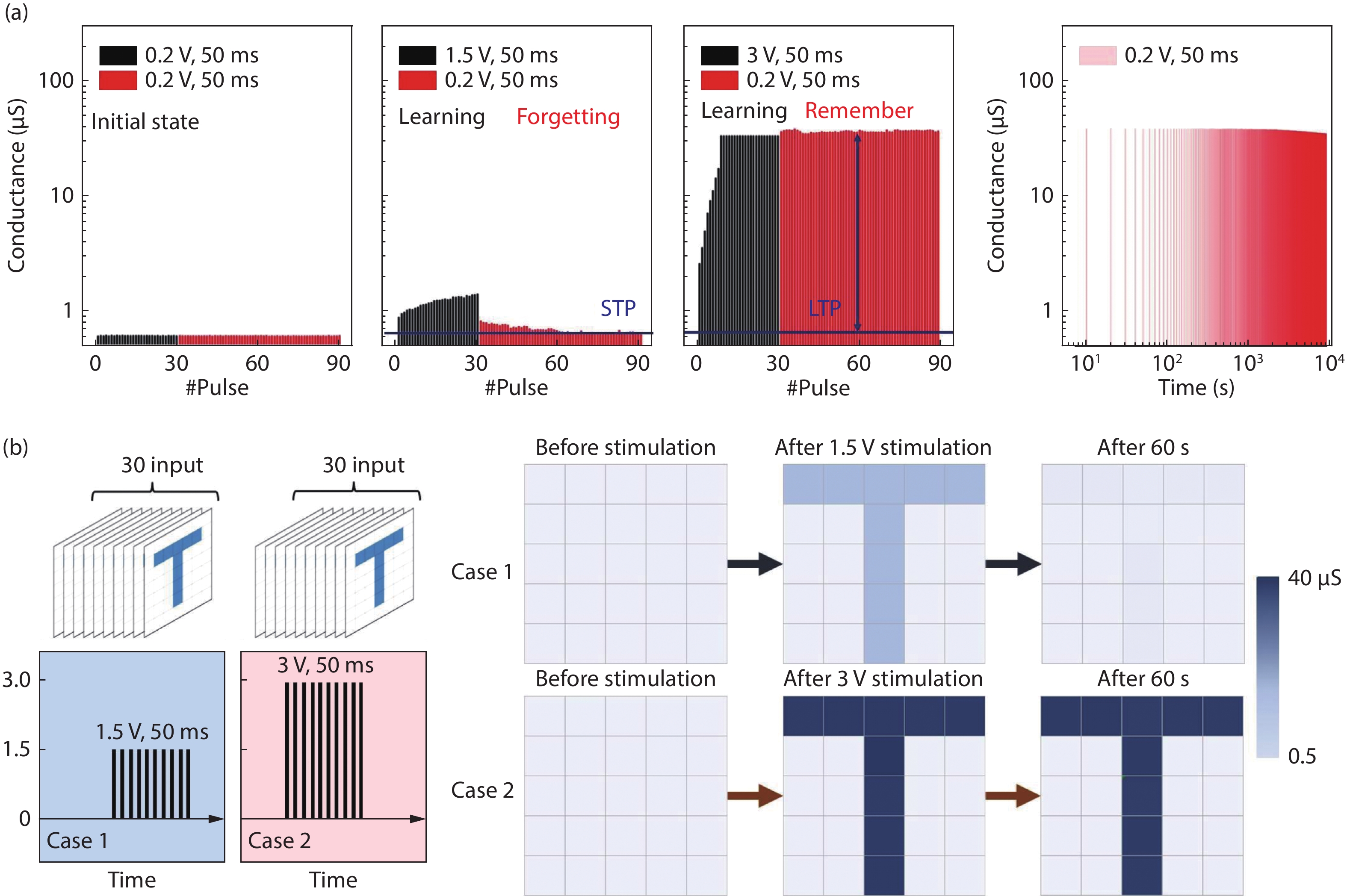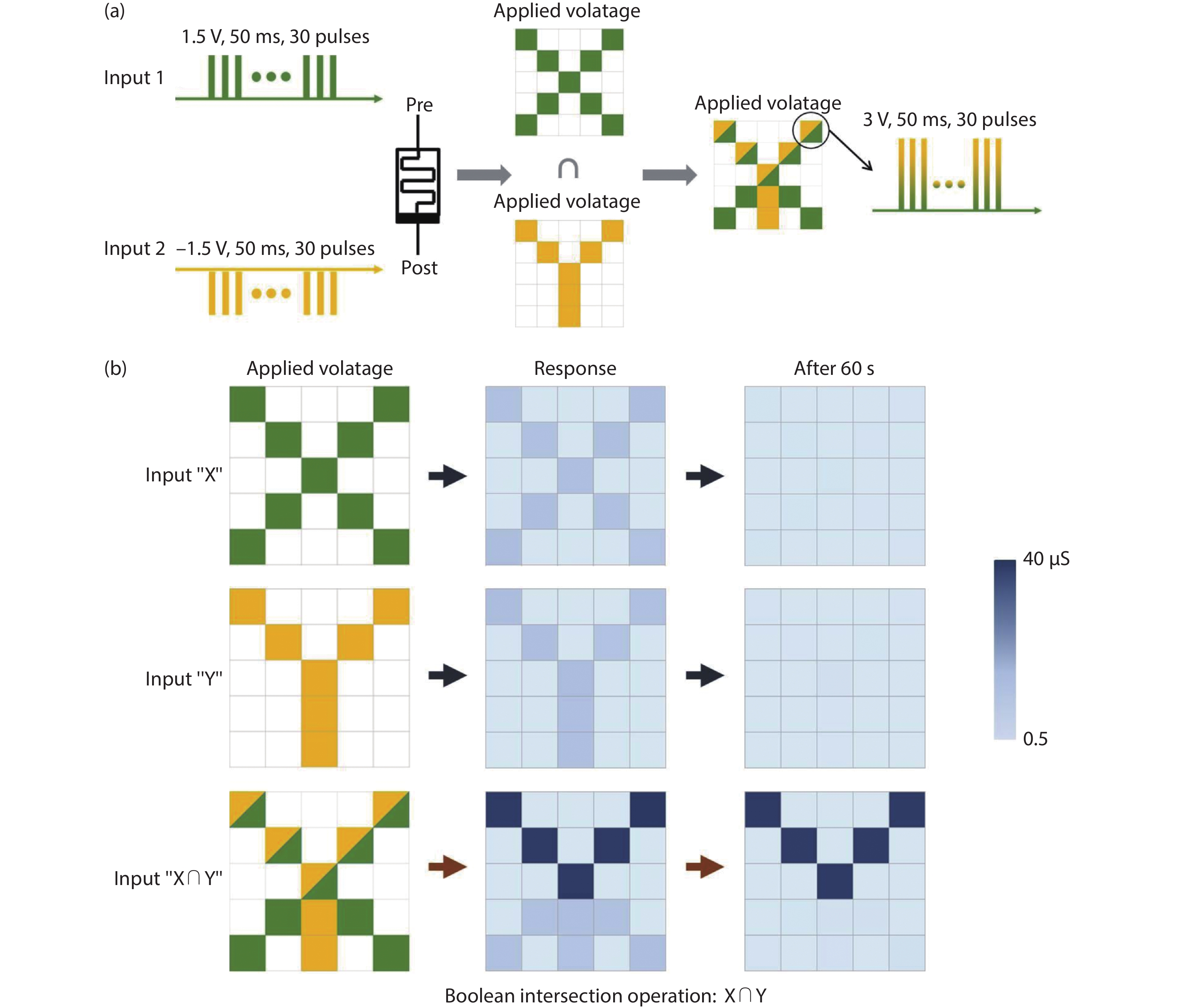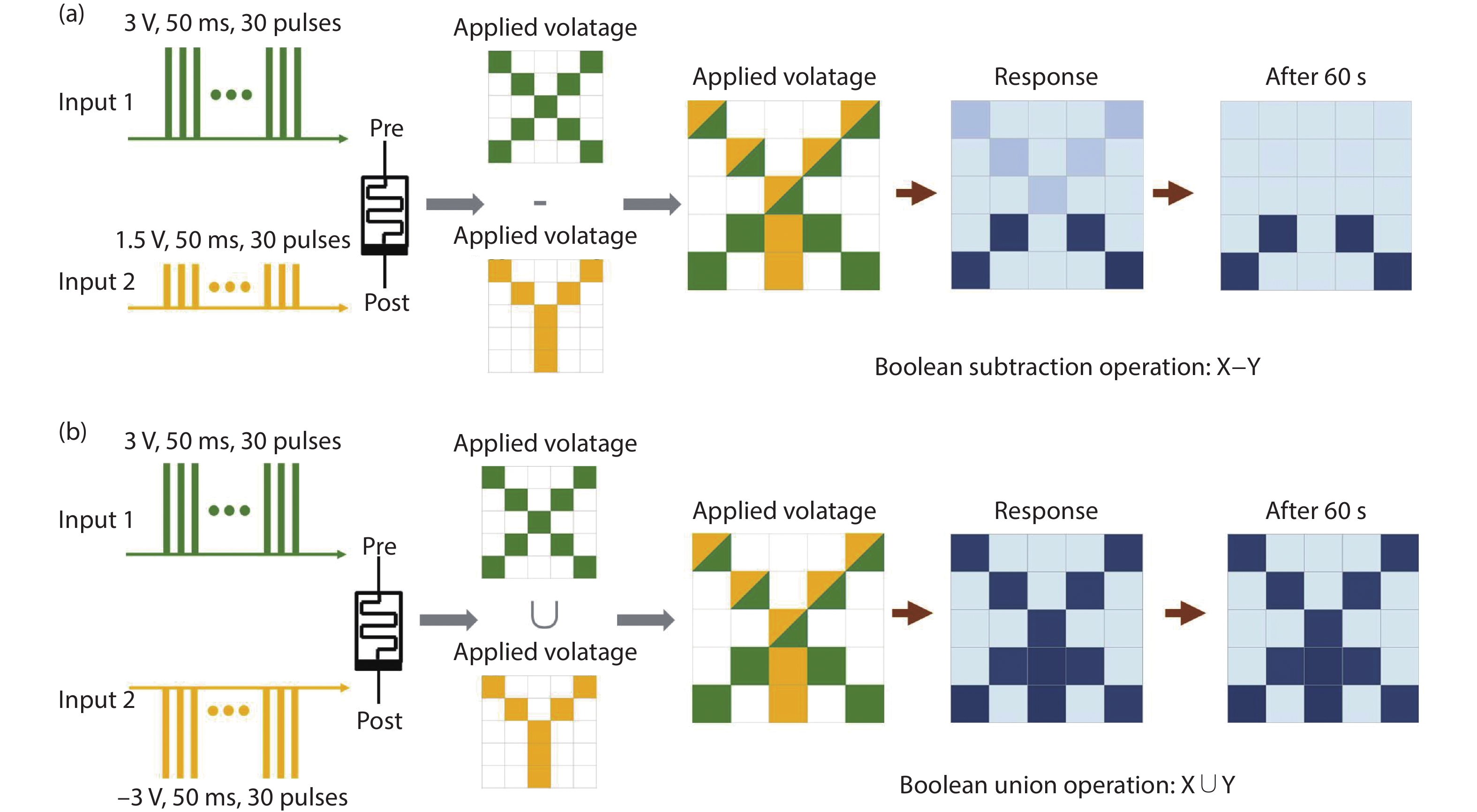| Citation: |
Jiajuan Shi, Ya Lin, Tao Zeng, Zhongqiang Wang, Xiaoning Zhao, Haiyang Xu, Yichun Liu. Voltage-dependent plasticity and image Boolean operations realized in a WOx-based memristive synapse[J]. Journal of Semiconductors, 2021, 42(1): 014102. doi: 10.1088/1674-4926/42/1/014102
****
J J Shi, Y Lin, T Zeng, Z Q Wang, X N Zhao, H Y Xu, Y C Liu, Voltage-dependent plasticity and image Boolean operations realized in a WOx-based memristive synapse[J]. J. Semicond., 2021, 42(1): 014102. doi: 10.1088/1674-4926/42/1/014102.
|
Voltage-dependent plasticity and image Boolean operations realized in a WOx-based memristive synapse
DOI: 10.1088/1674-4926/42/1/014102
More Information
-
Abstract
The development of electronic devices that possess the functionality of biological synapses is a crucial step towards neuromorphic computing. In this work, we present a WOx-based memristive device that can emulate voltage-dependent synaptic plasticity. By adjusting the amplitude of the applied voltage, we were able to reproduce short-term plasticity (STP) and the transition from STP to long-term potentiation. The stimulation with high intensity induced long-term enhancement of conductance without any decay process, thus representing a permanent memory behavior. Moreover, the image Boolean operations (including intersection, subtraction, and union) were also demonstrated in the memristive synapse array based on the above voltage-dependent plasticity. The experimental achievements of this study provide a new insight into the successful mimicry of essential characteristics of synaptic behaviors.
-
References
[1] Zidan M A, Strachan J P, Lu W D. The future of electronics based on memristive systems. Nat Electron, 2018, 1(1), 22 doi: 10.1038/s41928-017-0006-8[2] Yao P, Wu H, Gao B, et al. Fully hardware-implemented memristor convolutional neural network. Nature, 2020, 577(7792), 641 doi: 10.1038/s41586-020-1942-4[3] Wang Z, Joshi S, Savel’ev S, et al. Memristors with diffusive dynamics as synaptic emulators for neuromorphic computing. Nat Mater, 2017, 16(1), 101 doi: 10.1038/nmat4756[4] Wang Z Q, Xu H Y, Li X H, et al. Synaptic learning and memory functions achieved using oxygen ion migration/diffusion in an amorphous InGaZnO memristor. Adv Funct Mater, 2012, 22(13), 2759 doi: 10.1002/adfm.201103148[5] Yan X B, Zhao J H, Liu S, et al. Memristor with Ag-cluster-doped TiO2 films as artificial synapse for neuroinspired computing. Adv Funct Mater, 2018, 28(1), 1705320 doi: 10.1002/adfm.201705320[6] Wang J R, Zhuge F. Memristive synapses for brain-inspired computing. Adv Mater Technol, 2019, 4(3), 1800544 doi: 10.1002/admt.201800544[7] Ohno T, Hasegawa T, Tsuruoka T, et al. Short-term plasticity and long-term potentiation mimicked in single inorganic synapses. Nat Mater, 2011, 10(8), 591 doi: 10.1038/nmat3054[8] Kim S, Du C, Sheridan P, et al. Experimental demonstration of a second-order memristor and its ability to biorealistically implement synaptic plasticity. Nano Lett, 2015, 15(3), 2203 doi: 10.1021/acs.nanolett.5b00697[9] Jo S H, Chang T, Ebong I, et al. Nanoscale memristor device as synapse in neuromorphic systems. Nano Lett, 2010, 10(4), 1297 doi: 10.1021/nl904092h[10] Li Y, Zhong Y, Zhang J, et al. Activity-dependent synaptic plasticity of a chalcogenide electronic synapse for neuromorphic systems. Sci Rep, 2015, 4(1), 4906 doi: 10.1038/srep04906[11] Serrano-Gotarredona T, Masquelier T, Prodromakis T, et al. STDP and STDP variations with memristors for spiking neuromorphic learning systems. Front Neurosci, 2013, 7(2), 2 doi: 10.3389/fnins.2013.00002[12] Zucker R S, Regehr W G. Short-term synaptic plasticity. Annu Rev Physiol, 2002, 64(1), 355 doi: 10.1146/annurev.physiol.64.092501.114547[13] Debanne D, Gähwiler, B H, Thompson S M. Heterogeneity of synaptic plasticity at unitary CA3–CA1 and CA3–CA3 connections in rat hippocampal slice cultures. J Neurosci, 1999, 19(24), 10664 doi: 10.1523/JNEUROSCI.19-24-10664.1999[14] Kim M K, Lee J S. Short-term plasticity and long-term potentiation in artificial biosynapses with diffusive dynamics. ACS Nano, 2018, 12(2), 1680 doi: 10.1021/acsnano.7b08331[15] Wang Z, Zeng T, Ren Y et al. Toward a generalized Bienenstock-Cooper-Munro rule for spatiotemporal learning via triplet-STDP in memristive devices. Nat Commun, 2020, 11(1), 1510 doi: 10.1038/s41467-020-15158-3[16] Abraham W C, Gustafsson B, Wigström H. Single high strength afferent volleys can produce long-term potentiation in the hippocampus in vitro. Neurosci Lett, 1986, 70(2), 217 doi: 10.1016/0304-3940(86)90466-0[17] Yang J T, Ge C, Du J Y, et al. Artificial synapses emulated by an electrolyte-gated tungsten-oxide transistor. Adv Mater, 2018, 30(34), 1801548 doi: 10.1002/adma.201801548[18] Du J Y, Ge C, Riahi H, et al. Dual-gated MoS2 transistors for synaptic and programmable logic functions. Adv Electron Mater, 2020, 6(5), 1901408 doi: 10.1002/aelm.201901408[19] Lin Y, Zeng T, Xu H Y, et al. Transferable and flexible artificial memristive synapse based on WOx Schottky junction on arbitrary substrates. Adv Electron Mater, 2018, 4(12), 1800373 doi: 10.1002/aelm.201800373[20] Lin Y, Wang C, Ren Y, et al. Analog –digital hybrid memristive devices for image pattern recognition with tunable learning accuracy and speed. Small Methods, 2019, 3(10), 1900160 doi: 10.1002/smtd.201900160[21] Kamiya R, Zucher R S. Residual Ca2 + and short-term synaptic plasticity. Nature, 1994, 371, 603 doi: 10.1038/371603a0[22] Wang T Y, Meng J L, He Z Y, et al. Room-temperature developed flexible biomemristor with ultralow switching voltage for array learning. Nanoscale, 2020, 12(16), 9116 doi: 10.1039/D0NR00919A[23] Waser R, Aono M. Nanoionics-based resistive switching memories. Nanosci Technol, 2009, 158 doi: 10.1142/9789814287005_0016[24] Wang W, Xu J, Ma H, et al. Insertion of nanoscale AgInSbTe Layer between the Ag electrode and the CH3NH3PbI3 electrolyte layer enabling enhanced multilevel memory. ACS Appl Nano Mater, 2019, 2(1), 307 doi: 10.1021/acsanm.8b01928[25] Atkinson R C, Shiffrin R M. Human memory: A proposed system and its control processes. Psychol Learn Motiv, 1968, 2, 89 doi: 10.1016/S0079-7421(08)60422-3[26] Harary F, Wilcox G W. Boolean operations on graphs. Math Scand, 1967, 20(1), 41 doi: 10.7146/math.scand.a-10817[27] Satoh T, Chiyokura H. Boolean operations on sets using surface data. Proceedings of the First ACM Symposium on Solid Modeling Foundations and CAD/CAM Applications, 1991, 119[28] Mäntylä M. Boolean operations of 2-manifolds through vertex neighborhood classification. ACM Trans Graph, 1986, 5(1), 1 doi: 10.1145/7529.7530[29] Gardan Y, Perrin E. An algorithm reducing 3D Boolean operations to a 2D problem: concepts and results. Comput Aid Des, 1996, 28(4), 277 doi: 10.1016/0010-4485(95)00050-X -
Proportional views





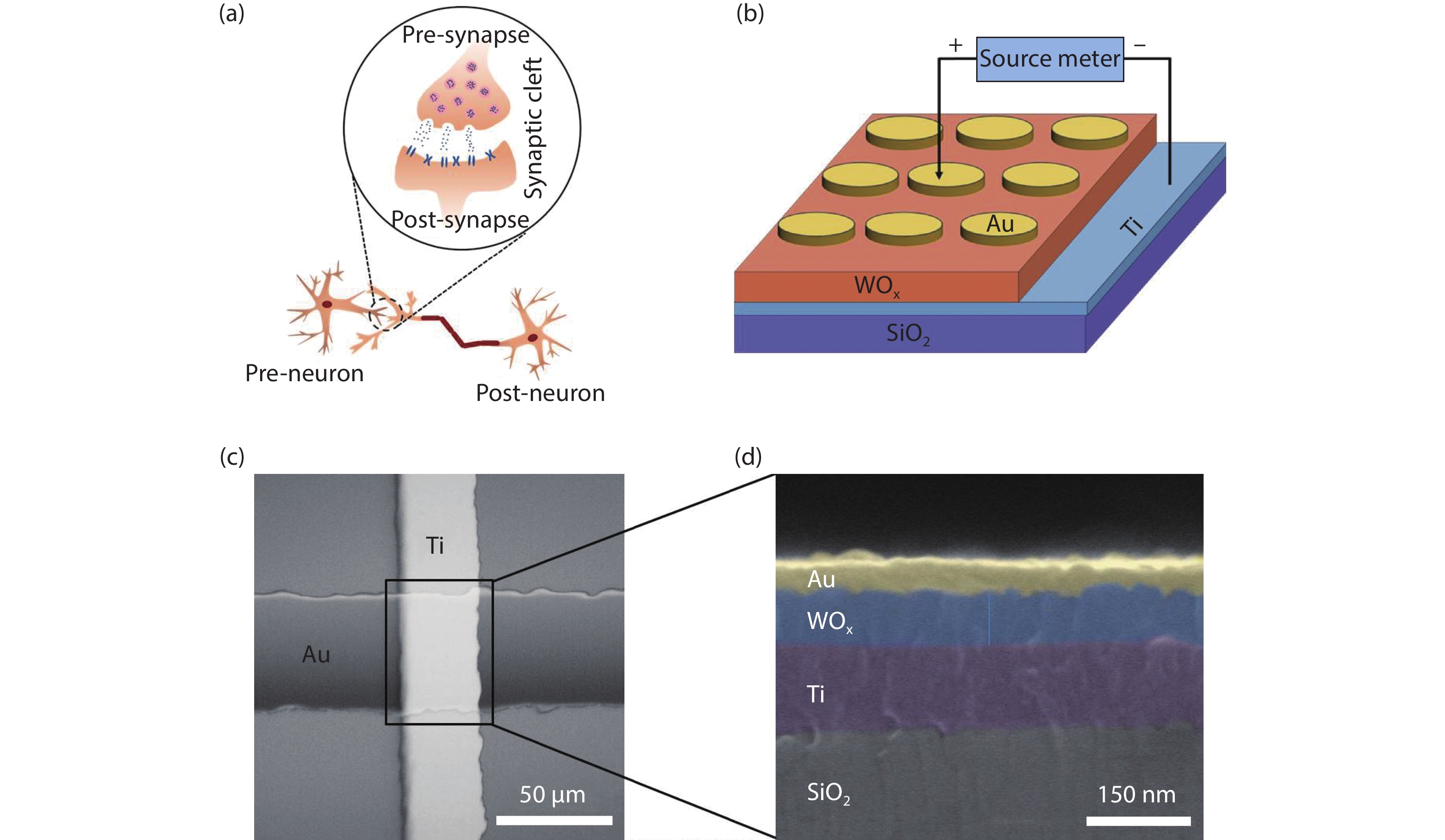
 DownLoad:
DownLoad:
